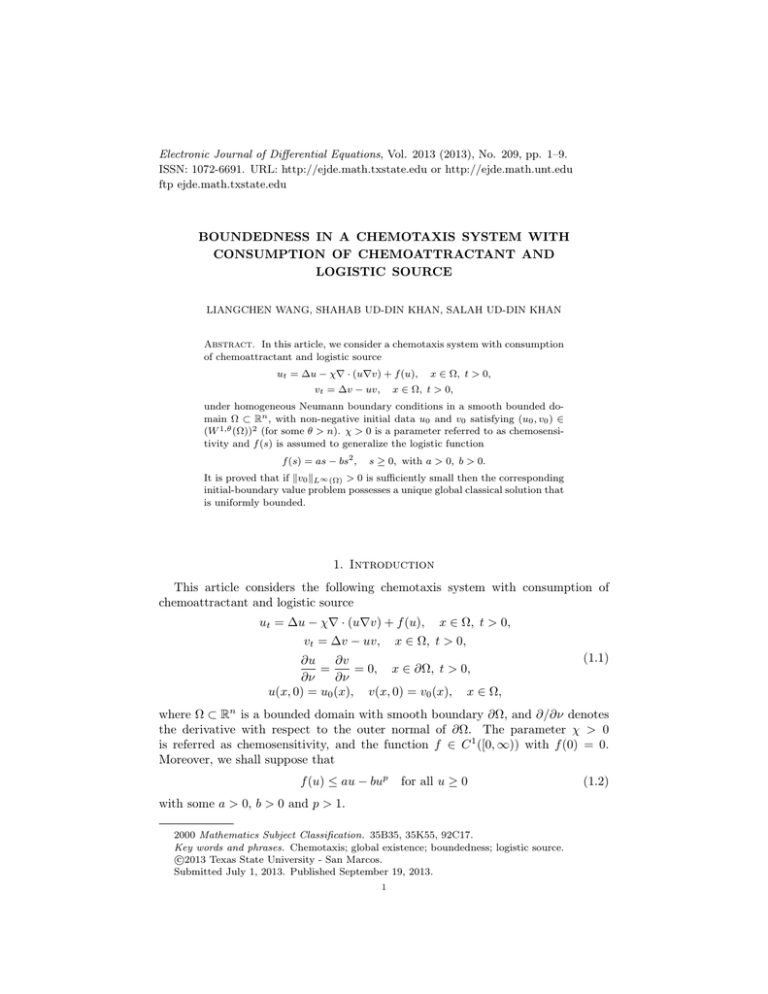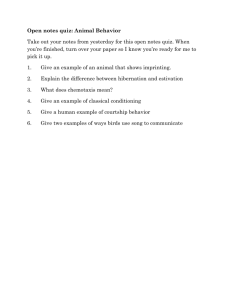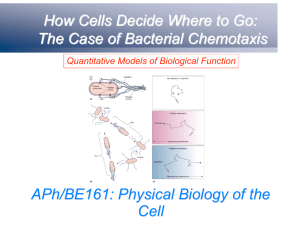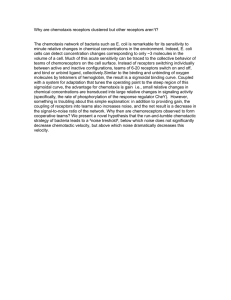Electronic Journal of Differential Equations, Vol. 2013 (2013), No. 209,... ISSN: 1072-6691. URL: or
advertisement

Electronic Journal of Differential Equations, Vol. 2013 (2013), No. 209, pp. 1–9.
ISSN: 1072-6691. URL: http://ejde.math.txstate.edu or http://ejde.math.unt.edu
ftp ejde.math.txstate.edu
BOUNDEDNESS IN A CHEMOTAXIS SYSTEM WITH
CONSUMPTION OF CHEMOATTRACTANT AND
LOGISTIC SOURCE
LIANGCHEN WANG, SHAHAB UD-DIN KHAN, SALAH UD-DIN KHAN
Abstract. In this article, we consider a chemotaxis system with consumption
of chemoattractant and logistic source
ut = ∆u − χ∇ · (u∇v) + f (u),
vt = ∆v − uv,
x ∈ Ω, t > 0,
x ∈ Ω, t > 0,
under homogeneous Neumann boundary conditions in a smooth bounded domain Ω ⊂ Rn , with non-negative initial data u0 and v0 satisfying (u0 , v0 ) ∈
(W 1,θ (Ω))2 (for some θ > n). χ > 0 is a parameter referred to as chemosensitivity and f (s) is assumed to generalize the logistic function
f (s) = as − bs2 ,
s ≥ 0, with a > 0, b > 0.
It is proved that if kv0 kL∞ (Ω) > 0 is sufficiently small then the corresponding
initial-boundary value problem possesses a unique global classical solution that
is uniformly bounded.
1. Introduction
This article considers the following chemotaxis system with consumption of
chemoattractant and logistic source
ut = ∆u − χ∇ · (u∇v) + f (u),
vt = ∆v − uv,
x ∈ Ω, t > 0,
x ∈ Ω, t > 0,
∂u
∂v
=
= 0, x ∈ ∂Ω, t > 0,
∂ν
∂ν
u(x, 0) = u0 (x), v(x, 0) = v0 (x), x ∈ Ω,
(1.1)
where Ω ⊂ Rn is a bounded domain with smooth boundary ∂Ω, and ∂/∂ν denotes
the derivative with respect to the outer normal of ∂Ω. The parameter χ > 0
is referred as chemosensitivity, and the function f ∈ C 1 ([0, ∞)) with f (0) = 0.
Moreover, we shall suppose that
f (u) ≤ au − bup
for all u ≥ 0
with some a > 0, b > 0 and p > 1.
2000 Mathematics Subject Classification. 35B35, 35K55, 92C17.
Key words and phrases. Chemotaxis; global existence; boundedness; logistic source.
c
2013
Texas State University - San Marcos.
Submitted July 1, 2013. Published September 19, 2013.
1
(1.2)
2
L. WANG, S. U.-D. KHAN, S. U.-D. KHAN
EJDE-2013/209
Equations (1.1) is the well-known Keller-Segel model, and the origin of this
fundamental model was introduced by Keller and Segel [13] to describe the motion
of cells which are diffusing and moving towards the concentration gradient of a
chemical signal substance called chemoattractant, the latter being produced by the
cells themselves. We refer the reader to the paper [10] where a comprehensive
information of further examples illustrating the outstanding biological relevance of
chemotaxis can be found. In this paper, we consider a mathematical model for the
motion of cells which towards the higher concentration of oxygen that is consumed
by the cells, where u = u(x, t) denotes the density of the cells and v = v(x, t)
represents the concentration of the oxygen.
During the past four decades, the Keller-Segel models have become one of the
best-study models in mathematical biology the Keller-Segel models have been studied extensively by many authors. For example, Keller and Segel [13] proposed the
following classical chemotaxis model
ut = ∆u − ∇ · (u∇v),
vt = ∆v − v + u,
x ∈ Ω, t > 0,
x ∈ Ω, t > 0,
(1.3)
which has been investigated successfully up to now and the main issue of the investigation was the solutions of the model are bounded or blow-up. If n = 1, in [19],
it was shown all solutions of (1.3) are global in time and bounded; if n = 2, then
all solutions of (1.3) are global in time and bounded provided that ku0 kL1 (Ω) < 4π
in [15], however, for almost every ku0 kL1 (Ω) > 4π, then the corresponding solutions
of (1.3) blow up either in finite or infinite time in [11] and that some radially symmetric solutions blow up in finite time in [9, 24]; if n ≥ 3, Winkler [25] showed that
ku0 kLn/2+ (Ω) and k∇v0 kLn+ (Ω) are small for all > 0, then the solution is global
in time and bounded, however, for any ku0 kL1 (Ω) > 0, then the radially symmetric
solution of (1.3) blows up either in finite or infinite time (see also [24, 26, 5]).
Involving a source term of logistic type in chemotaxis system have been studied
[10, 28, 18, 23, 16, 14]. The following initial-boundary value chemotaxis model with
logistic source
ut = ∆u − ∇ · (uχ(v)∇v) + f (u),
vt = ∆v − v + u,
x ∈ Ω, t > 0,
x ∈ Ω, t > 0.
(1.4)
If χ(v) is a constant, Winkler [28] studied proved that the solutions of problem (1.4)
are global and bounded provided that f (0) ≥ 0 as well as f (u) ≤ a − bu2 with some
χ0
a ≥ 0 and b is sufficiently large. If χ(v) ≤ (1+βv)
δ for all v ≥ 0 and some δ > 1,
χ0 > 0 and β > 0, the authors [14] shown that the model (1.4) with logistic source
f (u) satisfies (1.2) with p = 2 then solutions are global and bounded provided that
χ0 and a are sufficiently small, the authors [3] recent obtain the same result for all
positive values of χ0 and a, which improved the previous result.
The model (1.1) deals with the chemotaxis process where the signal is consumed
by the cells, rather than produced by the cells. In the absence of the logistic source
(i.e. f (u) ≡ 0) for problem (1.1), Tao [20] proved that the classical solution of
model (1.1) is uniformly bounded provided that kv0 kL∞ (Ω) is sufficiently small. In
particular, if Ω ⊂ R3 is a bounded convex domains, Tao and Winkler [22] showed
that there exists T > 0 such that the problem has global weak solution which is
bounded and smooth in Ω×(T, +∞). It is the goal of this paper to prove that model
EJDE-2013/209
BOUNDEDNESS IN A CHEMOTAXIS SYSTEM
3
(1.1) has global and bounded solutions provided that kv0 kL∞ (Ω) > 0 is sufficiently
small (Theorem 3.3).
2. Preliminaries
We first state one result concerning local-in-time existence of a classical solution
to problem (1.1).
Theorem 2.1. Let the non-negative functions u0 and v0 satisfy (u0 , v0 ) belong to
(W 1,θ (Ω))2 , for some θ > n. Moreover, f (s) with s ≥ 0 is smooth and f (0) = 0.
Then problem (1.1) has a unique local-in-time non-negative classical solution
(u, v) ∈ (C([0, Tmax ); W 1,θ (Ω)) ∩ C 2,1 (Ω × (0, Tmax )))2 ,
(2.1)
where Tmax denotes the maximal existence time. If for every T < +∞ both u(·, t)
and v(·, t) are a priori bounded for all 0 < t < min{T, Tmax }; i.e.,
k(u(·, t), v(·, t))kL∞ (Ω) ≤ C(T )
for all 0 < t < min{T, Tmax }
(2.2)
with some constant C(T ) depending on T and k(u0 , v0 )kW 1,θ (Ω) only. Then the
solution of (1.1) is globally defined and thus Tmax = +∞. Moreover, assume the
condition (1.2) is satisfied, then there exists a constant C0 > 0 such that u(x, t)
and v(x, t) satisfy
ku(·, t)kL1 (Ω) ≤ C0 ,
(2.3)
0 ≤ v ≤ kv0 kL∞ (Ω)
(2.4)
for all t ∈ (0, Tmax ).
Proof. As in [4, 20, 7], let V = (u, v) ∈ R2 . Then the initial-boundary value
problem (1.1) can be reformulated as
Vt = ∇ · (F (V )∇V ) + H(V )
∂V
= 0, x ∈ ∂Ω, t > 0,
∂ν
V (x, 0) = (u0 (x), v0 (x)), x ∈ Ω,
where
1 −χu
f (u)
, H(V ) =
.
0
1
−uv
Then applying [2, Theorems 14.4, 14.6, 15.5], statements (2.1) and (2.2) can be
proved. Since the initial data u0 ≥ 0, v0 ≥ 0 and f (0) = 0, the maximum principle
ensures that both u and v are non-negative.
By the maximum principle we have (2.4). Now, we prove (2.3). Integrating the
first equation in (1.1) and using (1.2), we obtain
Z
Z
Z
d
udx =
f (u)dx ≤
au − bup dx.
(2.5)
dt Ω
Ω
Ω
By Young’s inequality, since b > 0 and p > 1, we obtain
Z
Z
Z
p
1
−1/p
1/p
(a + 1)
u dx =
b
(a + 1)b u dx ≤
bup dx + (a + 1) p−1 b 1−p |Ω|. (2.6)
F (V ) =
Ω
Ω
Ω
Combining (2.5) and (2.6), we conclude
Z
Z
p
1
d
udx +
u dx ≤ (a + 1) p−1 b 1−p |Ω|.
dt Ω
Ω
(2.7)
4
L. WANG, S. U.-D. KHAN, S. U.-D. KHAN
Integrating, we have
Z
udx ≤ c0 ,
EJDE-2013/209
p
1
c0 = max{ku0 kL1 (Ω) , (a + 1) p−1 b 1−p |Ω|} > 0.
Ω
Let us collect some basic statements about the Gagliardo-Nirenberg inequality
which will be used in forthcoming proofs. For details, we refer the reader to [29, 8,
17] (see also [26, 5]).
Lemma 2.2. Let
(
∗
α =
2n
n−2 ,
∞,
if n > 2,
if n = 1, 2.
Then for all l∗ ∈ (2, ∞) satisfying l∗ ≤ α∗ and h ∈ (0, 2), α ∈ [h, l∗ ], there exists a
constant cGN > 0 such that
∗
∗
kψkLα (Ω) ≤ cGN (k∇ψkλL2 (Ω) kψk1−λ
+ kψkLh (Ω) )
Lh (Ω)
holds for any ψ ∈ W 1,2 (Ω), where λ∗ =
n
n
h−α
n
1− n
+
2
h
.
3. Global bounded solutions
The main step towards the existence and boundedness of a global solution is
to establish uniform bound of the cells population density u(x, t) in the space
Ln+1 (Ω). This is accomplished by providing some associated weighted bounds
involving weight functions φ(v) which are uniformly bounded both from above and
below by positive constants. This approach was developed by Winkler in [27] (see
also [14, 20]).
Lemma 3.1. Let f (u) satisfy (1.2), kv0 kL∞ (Ω) > 0 and χ > 0. Then there exists
a constant C > 0 such that the first component of the solution of (1.1) satisfies
ku(·, t)kLn+1 (Ω) ≤ C
for all t ∈ (0, Tmax ).
(3.1)
Proof. Set k := n + 1 and fix kv0 kL∞ (Ω) > 0 small such that
kv0 kL∞ (Ω) ≤
Define
2
φ(s) := e(αs)
where
r
1
.
6(n + 1)χ
for all 0 ≤ s ≤ kv0 kL∞ (Ω) ,
n
1
.
24(n + 1) kv0 kL∞ (Ω)
By direct calculation, from (1.1), we obtain
Z
1 d
uk φ(v)dx
k dt Ω
Z
Z
1
=
uk−1 φ(v)ut dx +
uk φ0 (v)vt dx
k
ZΩ
Z Ω
Z
k−1
=
u
φ(v)∆udx −
uk−1 φ(v)χ∇ · (u∇v)dx +
uk−1 φ(v)f (u)dx
Ω
Ω
Ω
Z
Z
1
1
k 0
u φ (v)∆v dx −
uk+1 vφ0 (v)dx
+
k Ω
k Ω
α=
(3.2)
EJDE-2013/209
BOUNDEDNESS IN A CHEMOTAXIS SYSTEM
Z
Z
uk−1 φ0 (v)∇u · ∇v dx
Z
Z
k−1
+ χ(k − 1)
u
φ(v)∇u · ∇v dx + χ
uk φ0 (v)|∇v|2 dx
Ω
Ω
Z
Z
+
uk−1 φ(v)f (u)dx −
uk−1 φ0 (v)∇u · ∇v dx
Ω
Ω
Z
Z
1
1
k 00
2
u φ (v)|∇v| dx −
uk+1 vφ0 (v)dx.
−
k Ω
k Ω
uk−2 φ(v)|∇u|2 dx −
= −(k − 1)
Ω
5
Ω
Since f (s) ≤ as − bsp and φ0 (s) ≥ 0 for all s ≥ 0, we have
Z
Z
Z
1 d
1
uk φ(v)dx + (k − 1)
uk−2 φ(v)|∇u|2 dx +
uk φ00 (v)|∇v|2 dx
k dt Ω
k Ω
Ω
Z
Z
k−1 0
≤ −2
u
φ (v)∇u · ∇v dx + χ(k − 1)
uk−1 φ(v)∇u · ∇v dx
Ω
Ω
Z
Z
Z
+χ
uk φ0 (v)|∇v|2 dx + a
uk φ(v)dx − b
uk+p−1 φ(v)dx.
Ω
Ω
(3.3)
(3.4)
Ω
By Young’s inequality, we obtain
Z
Z
k−1
uk−2 φ(v)|∇u|2 dx
−2
uk−1 φ0 (v)∇u · ∇v dx ≤
4
Ω
Ω
Z
4
φ02 (v)
+
uk
|∇v|2 dx
k−1 Ω
φ(v)
(3.5)
and
Z
χ(k − 1)
u
Ω
k−1
k−1
φ(v)∇u · ∇v dx ≤
4
Z
uk−2 φ(v)|∇u|2 dx
Z
+ χ2 (k − 1)
uk φ(v)|∇v|2 dx.
Ω
(3.6)
Ω
Thus, from (3.4)–(3.6) we obtain
Z
Z
Z
k−1
1
1 d
k
k−2
2
u φ(v)dx +
u
φ(v)|∇u| dx +
uk φ00 (v)|∇v|2 dx
k dt Ω
2
k Ω
Ω
Z
Z
02
4
k φ (v)
2
2
≤
u
|∇v| dx + χ (k − 1)
uk φ(v)|∇v|2 dx
k−1 Ω
φ(v)
Ω
Z
Z
Z
+χ
uk φ0 (v)|∇v|2 dx + a
uk φ(v)dx − b
uk+p−1 φ(v)dx.
Ω
Ω
(3.7)
Ω
Next Rwe show that the three terms on the right-hand side of (3.7) are dominated
by k1 Ω uk φ00 (v)|∇v|2 dx. To this end, for s ≥ 0, we compute
2
2
φ00 (s)
2
4
= α2 e(αs) + α4 s2 e(αs) ,
k
k
k
4 φ02 (s)
16 4 2 (αs)2
y2 (s) :=
,
=
α s e
k − 1 φ(s)
k−1
y1 (s) :=
2
y3 (s) := χ2 (k − 1)φ(s) = χ2 (k − 1)e(αs) ,
2
y4 (s) := χφ0 (s) = 2χα2 se(αs) .
6
L. WANG, S. U.-D. KHAN, S. U.-D. KHAN
EJDE-2013/209
By a direct calculation, we obtain
y2 (s)
≤
1
3 y1 (s)
16
4 2 (αs)2
k−1 α s e
2 2 (αs)2
3k α e
24k
24(n + 1)
(αs)2 ≤
(αkv0 kL∞ (Ω) )2 = 1,
k−1
n
q
n
1
where we have used that α = 24(n+1)
kv0 kL∞ (Ω) . Using (3.2),
=
(3.8)
2
y3 (s)
3k(k − 1)χ2
χ2 (k − 1)e(αs)
= 36(n + 1)2 kv0 k2L∞ (Ω) χ2 ≤ 1
≤
≤
1
2 2 (αs)2
2
2α
y
(s)
α
e
3 1
3k
and
(3.9)
2
y4 (s)
2χα2 se(αs)
1
≤ 2 2 (αs)2 ≤ 3kχs ≤ 3(n + 1)χkv0 kL∞ (Ω) ≤ .
1
2
y
(s)
α
e
3 1
3k
Therefore, from (3.7)-(3.10), it follows easily that
Z
Z
Z
d
2(k − 1)
k
k+p−1
u φ(v)dx + kb
u
φ(v)dx +
|∇uk/2 |2 φ(v)dx
dt Ω
k
Ω
Ω
Z
k
≤ ka
u φ(v)dx.
(3.10)
(3.11)
Ω
2
Since 0 ≤ s ≤ kv0 kL∞ (Ω) , we have 1 ≤ φ(s) ≤ e(αkv0 kL∞ (Ω) ) := d, it is not difficult
to obtain
Z
Z
kb
uk φ(v)dx ≤ kb
uk+p−1 φ(v)dx + kbd|Ω|.
(3.12)
Ω
Ω
Combining (3.11) with (3.12) yields
Z
Z
Z
2(k − 1)
d
uk φ(v)dx + kb
uk φ(v)dx +
|∇uk/2 |2 φ(v)dx
dt Ω
k
Ω
Ω
Z
k
≤ ka
u φ(v)dx + kbd|Ω|.
(3.13)
Ω
Using Lemma 2.2 and (x + y)γ ≤ 2γ (xγ + y γ ) for all x, y ≥ 0 and γ > 0, we obtain
Z
Z
k
ka
u φ(v)dx ≤ kad
uk dx
Ω
Ω
= kadkuk/2 k2L2 (Ω)
≤ kad(cGN k∇uk/2 kλL2 (Ω) kuk/2 k1−λ
+ cGN kuk/2 kL2/k (Ω) )2
L2/k (Ω)
k(1−λ)
≤ 4kad(c2GN c0
2
k
k∇uk/2 k2λ
L2 (Ω) + cGN c0 )
(3.14)
holds with some constant cGN > 0 and
λ=
1
kn
n
2 − 2
− n2 + kn
2
∈ (0, 1).
By Young’s inequality, we derive
Z
k(1−λ)
2
k
ka
uk φ(v)dx ≤ 4kadc2GN c0
k∇uk/2 k2λ
L2 (Ω) + 4kadcGN c0
Ω
Z
2(k − 1)
≤
|∇uk/2 |2 dx + c1
k
Ω
Z
2(k − 1)
|∇uk/2 |2 φ(v)dx + c1 ,
≤
k
Ω
(3.15)
EJDE-2013/209
BOUNDEDNESS IN A CHEMOTAXIS SYSTEM
7
where
1
2k − 2 −λ 1−λ
) )
+ 4kadc2GN ck0 > 0.
k
Hence, substituting (3.15) into (3.13) yields
Z
Z
d
uk φ(v)dx + kb
uk φ(v)dx ≤ c1 + kbd|Ω|.
dt Ω
Ω
Integrating (3.16), we have
Z
Z
Z
c1 + kbd|Ω| uk dx ≤
uk φ(v)dx ≤ max d
uk0 ,
,
kb
Ω
Ω
Ω
we arrive at the desired result.
c1 = ck0 (4kadc2GN (
(3.16)
Remark 3.2. To prove that the three terms on the right-hand side of (3.7) are
R
dominated by k1 Ω uk φ00 (v)|∇v|2 dx, we need 1yyi (s)
≤ 1 (i = 2, 3, 4), so we have
(s)
3
1
1
1
0 < kv0 kL∞ (Ω) ≤ 6kχ
, in such a way that 6kχ
→ 0 as k → ∞. In fact, in the proof
of Theorem 3.3 is only applied to one fixed k > n. So to avoid this situation, we
choose k := n + 1 in Lemma 3.1.
We are now in a position to prove our main results, which are as follows.
Theorem 3.3. Assume that u0 (x) and v0 (x) are non-negative functions and that
(u0 , v0 ) belongs to (W 1,θ (Ω))2 for some θ > n, χ > 0, f (u) satisfies (1.2). Then
problem (1.1) possesses a unique global classical solution (u, v) for which both u and
v are non-negative and uniformly bounded in Ω × (0, ∞) provided that
1
0 < kv0 kL∞ (Ω) ≤
.
6(n + 1)χ
Proof. With the aid of Lemma 3.1 and its proof, based on a Moser-Alikakos-type
iterative procedure [1, 6] (for detailed calculations we refer to [14, 20, 21]), we can
establish a uniform bound on the solution u in time (0, Tmax ). Combining (2.4) and
(2.2) we obtain the desired result of Theorem 3.3.
Acknowledgments. We would like to thank the anonymous reviewers for their
valuable suggestions and fruitful comments which led to significant improvement of
this work. The third author would like to extend his sincere appreciation to deanship of scientific research at King Saud University for its funding of this research
through the research group project no. RGP-VPP-255.
References
Lp
[1] N. D. Alikakos;
bounds of solutions of reaction-diffusion equations, Comm. Partial Differential Equations 4 (1979) 827-868.
[2] H. Amann; Nonhomogeneous linear and quasilinear elliptic and parabolic boundary value
problems, in: H. J. Schmeisser, H. Triebel (Eds.), Functi on Spaces, Differential Operators
and Nonlinear Analysis, in: Teubner-Texte Math., vol. 133, Teubner, Stuttgart, Leipzig,
1993, pp. 9-126.
[3] K. Baghaei, M. Hesaaraki; Global existence and boundedness of classical solutions for
a chemotaxis model with logistic source, C. R. Acad. Sci. Paris, Ser. I (2013), http:
//dx.doi.org/10.1016/j.crma.2013.07.027.
[4] Y. S. Choi, Z. A. Wang; Prevention of blow-up by fast diffusion in chemotaxis, J. Math.
Anal. Appl. 362 (2010) 553-564.
[5] T. Cieślak, C. Stinner; Finite-time blowup and global-in-time unbounded solutions to a
parabolic-parabolic quasilinear Keller-Segel system in higher dimensions, J. Differential Equations 252 (2012) 5832-5851.
8
L. WANG, S. U.-D. KHAN, S. U.-D. KHAN
EJDE-2013/209
[6] L. Corrias, B. Perthame, H. Zaag; Lp and L∞ a priori estimates for some chemotaxis models
and applications to the Cauchy problem (dynamics of spatio-temporal patterns for the system
of reaction-diffusion equations), Kyoto Univ., RIMS 1416 (2005) 105-119.
[7] M. Delgado, I. Gayte, C. Morales-Rodrigo, A. Suárez; An angiogenesis model with nonlinear
chemotactic response and flux at the tumor boundary, Nonlinear Anal. 72 (2010) 330-347.
[8] A. Friedman; Partial Differential Equations, Holt, Rinehart and Winston, New York, 1969.
[9] M. A. Herrero, J. J. L. Velázquez; A blow-up mechanism for a chemotaxis model, Ann. Sc.
Norm. Super. Pisa Cl. Sci. (4) 24 (1997) 633-683.
[10] T. Hillen, K. J. Painter; A user’s guide to PDE models for chemotaxis, J. Math. Biol. 58
(2009) 183-217.
[11] D. Horstmann, G. Wang; Blow-up in a chemotaxis model without symmetry assumptions,
European J. Appl. Math. 12 (2001) 159-177.
[12] D. Horstmann, M. Winkler; Boundedness vs. blow-up in a chemotaxis system, J. Differential
Equations 215 (2005) 52-107.
[13] E. F. Keller, L. A. Segel; Initiation of slime mold aggregation viewed as an instability, J.
Theoret. Biol. 26 (1970) 399-415.
[14] C. L. Mu, L. C. Wang, P. Zheng, Q. N. Zhang; Global existence and boundedness of classical
solutions to a parabolic-parabolic chemotaxis system, Nonlinear Anal. Real World Appl. 14
(2013) 1634-1642.
[15] T. Nagai, T. Senba, K. Yoshida; Application of the Trudinger-Moser inequality to a parabolic
system of chemotaxis, Funkcial. Ekvac. Ser. Int. 40 (1997) 411-433.
[16] E. Nakaguchi, K. Osaki; Global existence of solutions to a parabolic-parabolic system for
chemotaxis with weak degradation, Nonlinear Anal. 74 (2011) 286-297.
[17] L. Nirenberg; An extended interpolation inequality, Ann. Sc. Norm. Super. Pisa Cl. Sci. (3)
20 (1966) 733-737.
[18] K. Osaki, T. Tsujikawa, A. Yagi, M. Mimura; Exponential attractor for a chemotaxis-growth
system of equations, Nonlinear Anal. 51 (2002) 119-144.
[19] K. Osaki, A. Yagi; Finite dimensional attractors for one-dimensional Keller-Segel equations,
Funkcial. Ekvac. 44 (2001) 441-469.
[20] Y. Tao; Boundedness in a chemotaxis model with oxygen consumption by bacteria, J. Math.
Anal. Appl. 381 (2011) 521-529.
[21] Y. Tao, M. Winkler; Boundedness in a quasilinear parabolic-parabolic Keller-Segel system
with subcritical sensitivity, J. Differential Equations 252 (2012) 692-715.
[22] Y. Tao, M. Winkler; Eventual smoothness and stabilization of large-data solutions in a threedimensional chemotaxis system with consumption of chemoattractant, J. Differential Equations 252 (2012) 2520-2543.
[23] J. I. Tello, M. Winkler; A chemotaxis system with logistic source, Comm. Partial Differential
Equations 32 (6) (2007) 849-877.
[24] M. Winkler; Does a ‘volume-filling effect’ always prevent chemotactic collapse?, Math. Methods Appl. Sci. 33 (2010) 12-24.
[25] M. Winkler; Aggregation vs. global diffusive behavior in the higher-dimensional Keller-Segel
model, J. Differential Equations 248 (2010) 2889-2905.
[26] M. Winkler; Finite-time blow-up in the higher-dimensional parabolic-parabolic Keller-Segel
system, J. Math. Pures Appl.(2013), http://dx.doi.org/10.1016/j.matpur.2013.01.020.
[27] M. Winkler; Absence of collapse in a parabolic chemotaxis system with signal-dependent
sensitivity, Math. Nachr. 283 (2010) 1664-1673.
[28] M. Winkler; Boundedness in the Higher-Dimensional Parabolic-Parabolic Chemotaxis System
with Logistic Source, Comm. Partial Differential Equations 35 (2010) 1516-1537.
[29] M. Winkler, K. C. Djie; Boundedness and finite-time collapse in a chemotaxis system with
volume-filling effect, Nonlinear Anal. 72 (2010) 1044-1064.
Liangchen Wang
College of Mathematics and Statistics, Chongqing University, Chongqing 401331, China
E-mail address: liangchenwang324@126.com
Shahab Ud-Din Khan
College of Mathematics and Statistics, Chongqing University, Chongqing 401331, China
E-mail address: sudkhan@163.com
EJDE-2013/209
BOUNDEDNESS IN A CHEMOTAXIS SYSTEM
9
Salah Ud-Din Khan
College of Engineering, King Saud University, P.O. Box 800, Riyadh 11421, Kingdom of
Saudi Arabia
E-mail address: salahudkhan@126.com




![MA3422 (Functional Analysis 2) Tutorial sheet 7 [March 13, 2015] Name: Solutions](http://s2.studylib.net/store/data/010731576_1-7cab095e21e09d2afe2aa723de414bb1-300x300.png)

